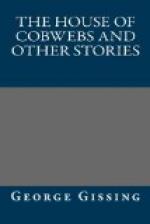’Is there at this moment any boy of twenty, fairly educated, but without means, without help, with nothing but the glow in his brain and steadfast courage in his heart, who sits in a London garret and writes for dear life? There must be, I suppose; yet all that I have read and heard of late years about young writers, shows them in a very different aspect. No garretteers, these novelists and journalists awaiting their promotion. They eat—and entertain their critics—at fashionable restaurants, they are seen in expensive seats at the theatre; they inhabit handsome flats—photographed for an illustrated paper on the first excuse. At the worst, they belong to a reputable club, and have garments which permit them to attend a garden party or an evening “at home” without attracting unpleasant notice. Many biographical sketches have I read during the last decade, making personal introduction of young Mr. This or young Miss That, whose book was—as the sweet language of the day will have it—“booming”; but never one in which there was a hint of stern struggles, of the pinched stomach and frozen fingers.’
[Footnote 3: Three vols., 1884, dedicated to M.C.R. In one volume ‘revised,’ 1895 (preface dated October 1895).]
[Footnote 4: Who but Gissing could describe a heroine as exhibiting in her countenance ’habitual nourishment on good and plenteous food’?]
In his later years it was customary for him to inquire of a new author ’Has he starved’? He need have been under no apprehension. There is still a God’s plenty of attics in Grub Street, tenanted by genuine artists, idealists and poets, amply sufficient to justify the lamentable conclusion of old Anthony a Wood in his life of George Peele. ’For so it is and always hath been, that most poets die poor, and consequently obscurely, and a hard matter it is to trace them to their graves.’ Amid all these miseries, Gissing upheld his ideal. During 1886-7 he began really to write and the first great advance is shown in Isabel Clarendon.[5] No book, perhaps, that he ever wrote is so rich as this in autobiographical indices. In the melancholy Kingcote we get more than a passing phase or a momentary glimpse at one side of the young author. A long succession of Kingcote’s traits are obvious self-revelations. At the beginning he symbolically prefers the old road with the crumbling sign-post, to the new. Kingcote is a literary sensitive. The most ordinary transaction with uneducated (’that




